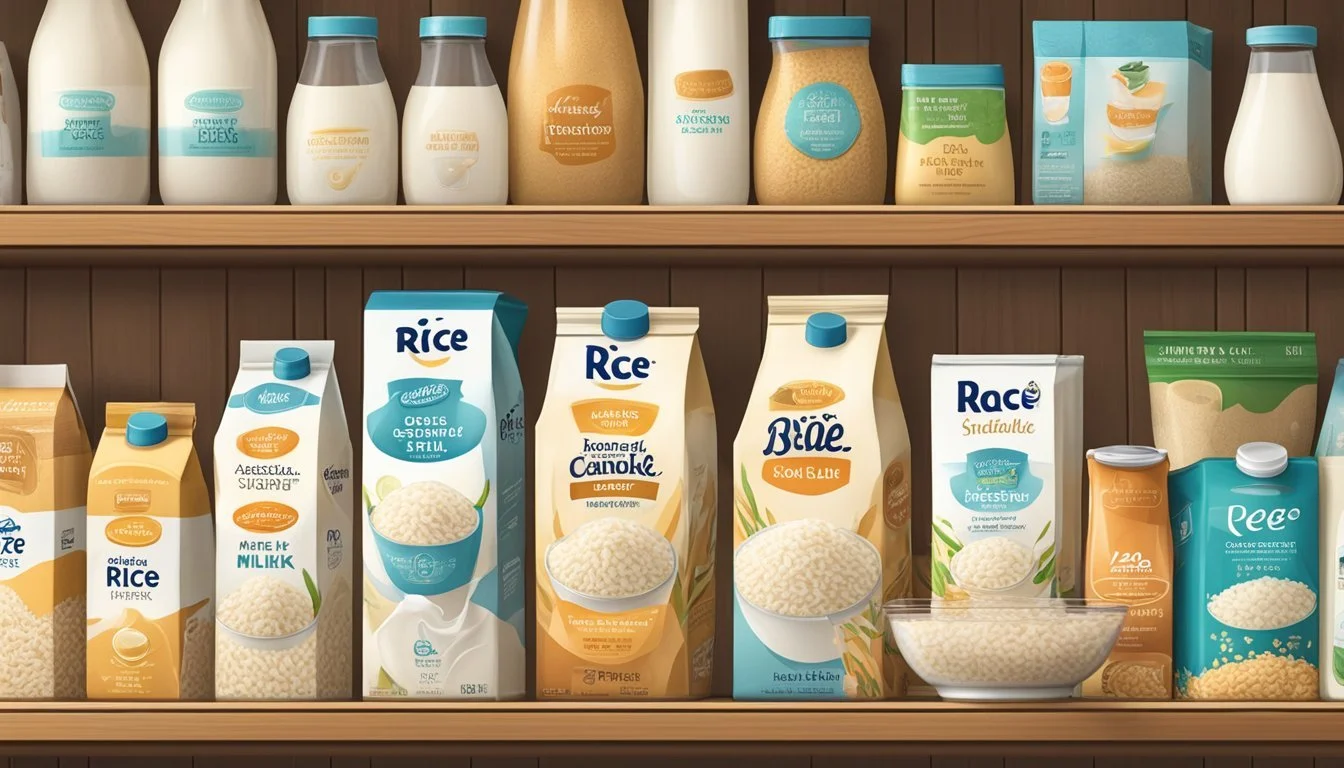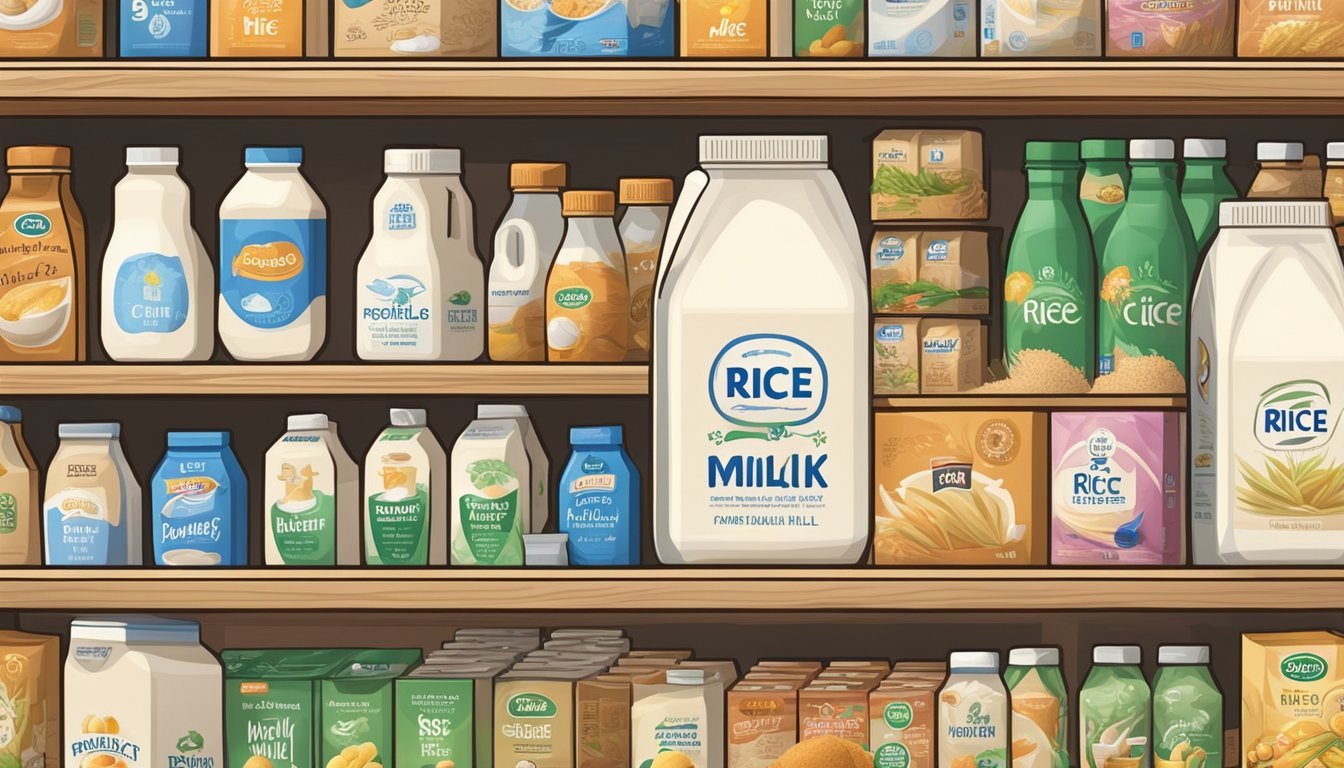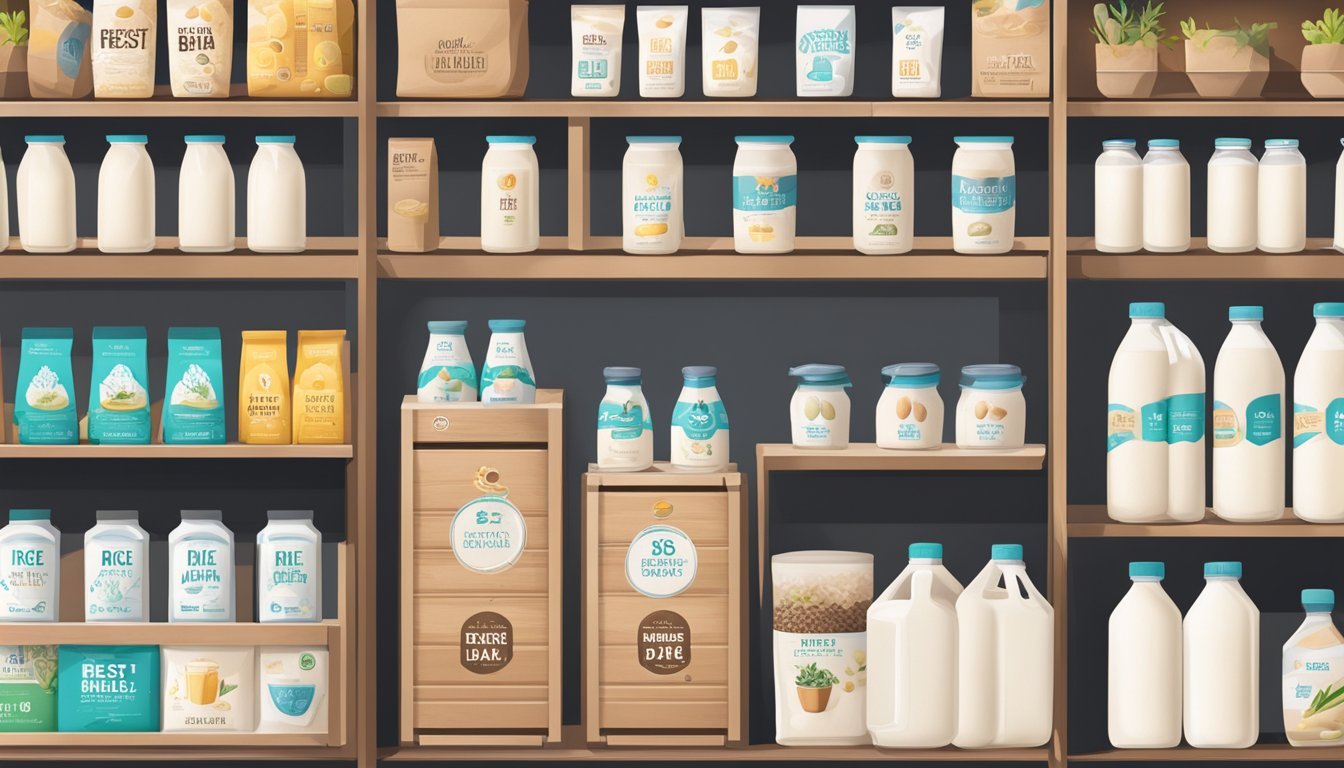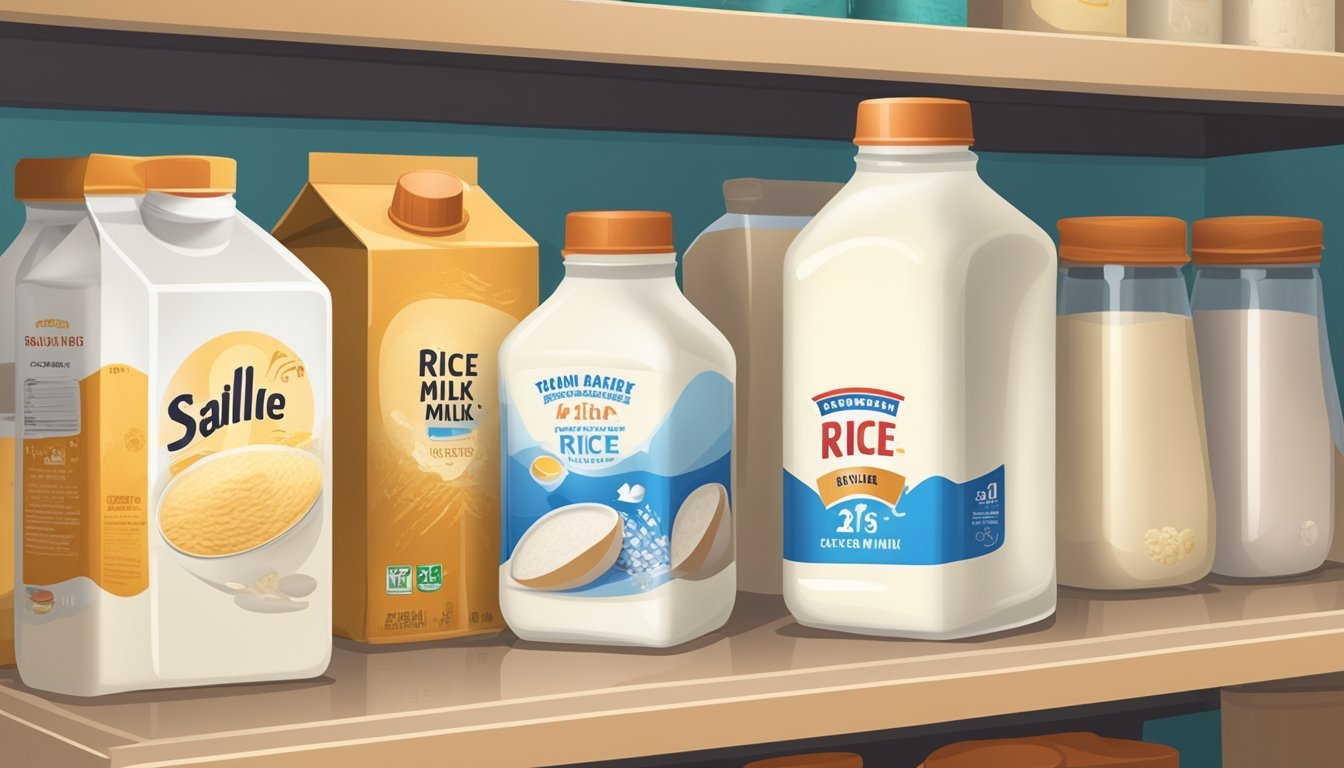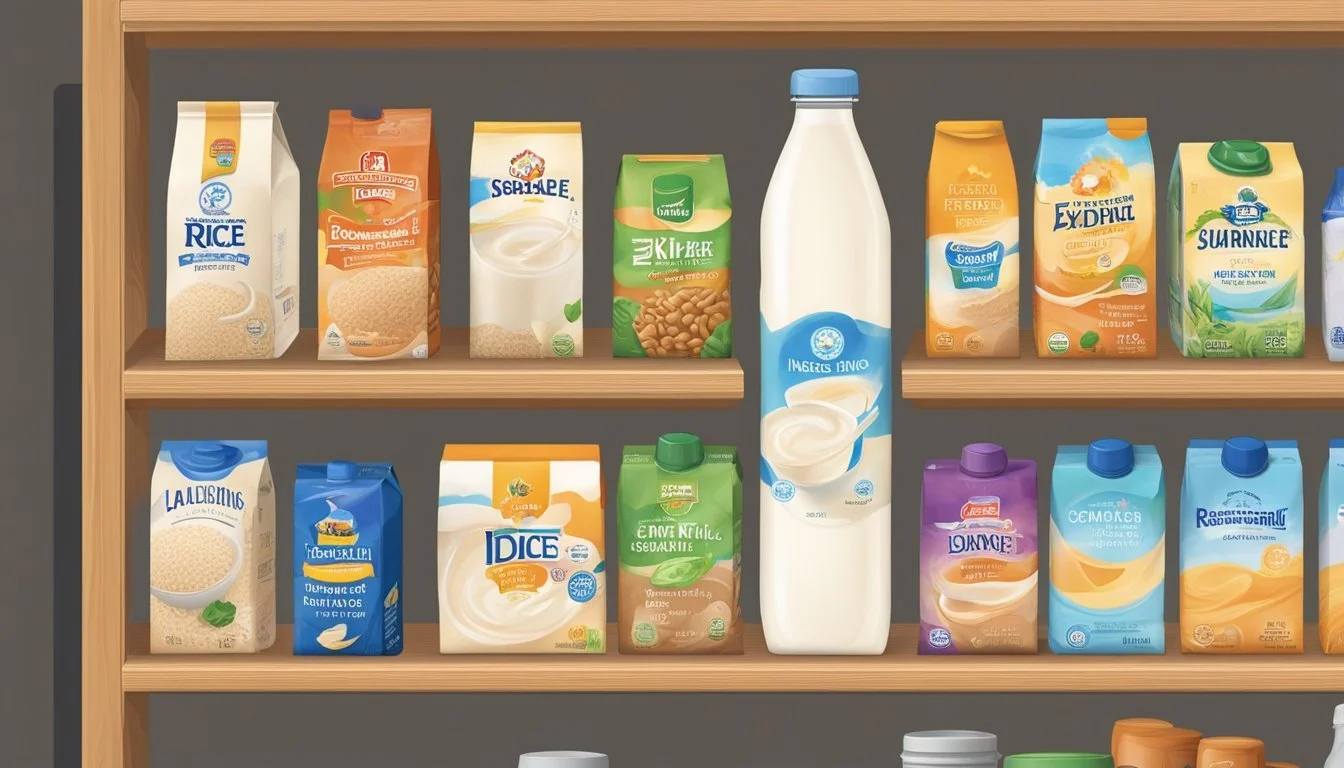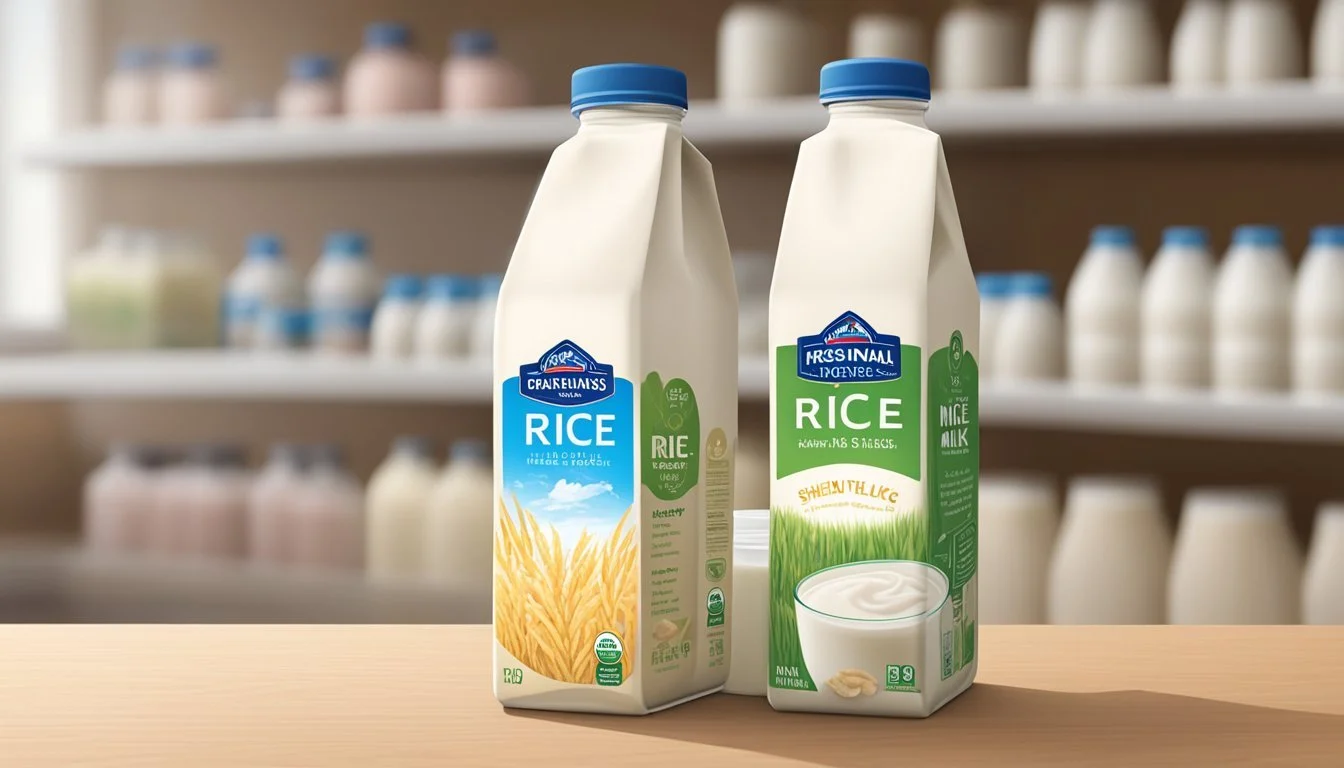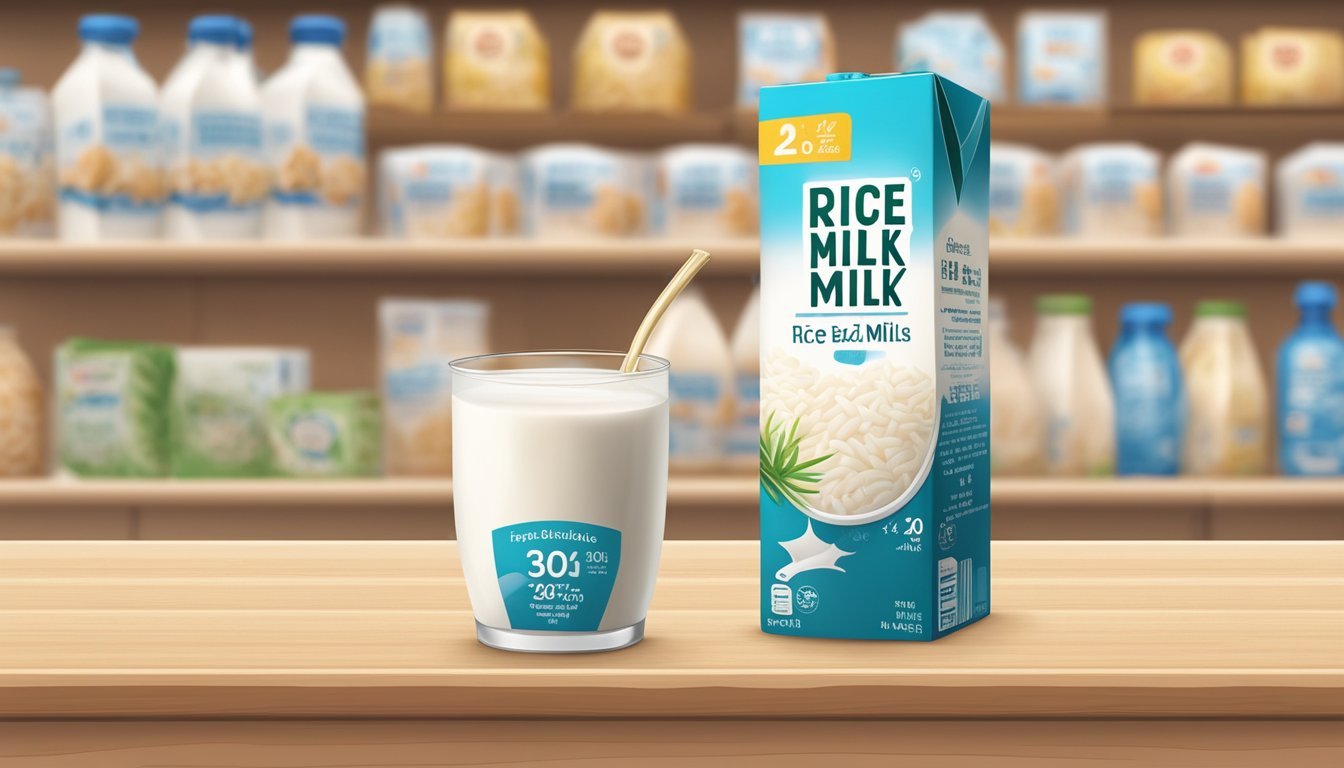How Long Does Boxed Rice Milk Last?
Uncovering Shelf-Stable Duration
Boxed rice milk, a popular dairy alternative, is designed for longevity and convenience. Unlike its refrigerated counterparts, shelf-stable rice milk can last for several months when unopened. This extended shelf life is made possible by the aseptic packaging process that seals the milk in a sterile environment, which prevents the growth of bacteria and other pathogens. It's a handy option for those who prefer non-dairy milk options but may not have frequent access to fresh groceries.
Once opened, however, the shelf life of rice milk changes significantly. It must be refrigerated and ideally consumed within 7 to 10 days. Storage conditions play a crucial role in maintaining its freshness once the aseptic seal is broken. Consumers should ensure that the rice milk is stored in the refrigerator at a consistent temperature to preserve its quality for as long as possible. It is important to note that the texture, taste, and nutritional content of rice milk are best when consumed within this timeframe, beyond which it should be discarded to avoid potential spoilage.
Understanding Rice Milk and Shelf Stability
Shelf-stable rice milk offers a convenient and long-lasting alternative to traditional dairy milk, due to its special processing and packaging techniques which provide longevity without the need for refrigeration.
The Basics of Shelf-Stable Rice Milk
Shelf-stable rice milk is a type of plant-based milk that remains safe to consume at room temperature for an extended period before opening. The key to its shelf stability lies in the high-temperature treatment and aseptic packaging. Unlike regular rice milk that requires refrigeration, shelf-stable variants are treated with ultra-high temperature (UHT) pasteurization or sterilization, which eliminates harmful bacteria and enzymes that lead to spoilage.
Aseptic Processing and Packaging
The aseptic processing technique involves heating the rice milk to a sterilizing temperature and then cooling it rapidly. This process is followed by filling the milk into pre-sterilized packages under a sterile atmosphere in the packaging line. Aseptic packaging materials often consist of multiple layers including paperboard, plastic, and aluminum, which create a barrier against light and oxygen, thereby extending the product's lifespan. The result is boxed milk that maintains its quality and safety for months, making it an ideal product for those seeking shelf-stable options.
Storage Guidelines for Unopened Rice Milk
Unopened rice milk's longevity greatly depends on how it's stored prior to its first use. Ensuring proper storage conditions and temperature management can maintain the quality and safety of the product.
Proper Storage Conditions
Unopened rice milk should be kept in its original packaging when stored to maintain quality. It is essential to place the box in a cool, dry place away from direct sunlight. A pantry or a kitchen cabinet away from any heat source makes an ideal storage location. This helps to protect the rice milk from environmental factors that could affect its taste and nutritional value.
Temperature Considerations
Maintaining a consistent, moderate temperature is critical for preserving unopened rice milk. It should be kept at room temperature, generally understood to be around 68°F (20°C) to 72°F (22°C), which is typically the normal ambient temperature of a house. Fluctuations and high temperatures can shorten its shelf life and lead to spoilage. It is not necessary to store unopened rice milk in an airtight container, as the packaging is designed to be shelf-stable.
Determining the Shelf Life of Rice Milk
When purchasing rice milk, consumers often wonder about its shelf life and how long they can expect it to maintain freshness. This section addresses the key factors and indicators to consider for the longevity of rice milk.
Expiration Date and Freshness
Expiration Date: Rice milk containers are typically stamped with an expiration date, which should be the primary indicator of their shelf stability. This date is the manufacturer's estimate of how long the rice milk will remain at peak quality. For unopened shelf-stable rice milk, consumers can expect it to last until this printed date as long as it is stored properly.
Assessing Freshness: Once opened, rice milk should be kept refrigerated and usually remains fresh for about 7 to 10 days. The freshness can be determined by checking the appearance, smell, and taste of the rice milk. Any off odors, discoloration, or sour taste indicates that the rice milk is no longer fresh.
Factors Affecting Shelf Life
Preservatives: The presence of preservatives can significantly extend the shelf life of rice milk. Preservatives work to prevent microbial growth, which can spoil the milk.
Stabilizers: Similarly, stabilizers are added to maintain the consistency and extend the shelf life of rice milk. They prevent separation and degradation of the product while on the shelf.
Storage Conditions: To maximize shelf life, unopened rice milk should be stored in a cool, dark place. Once opened, it must be refrigerated immediately.
Packaging Integrity: Any damage to the packaging, such as leaks or bloating, can compromise the shelf life of rice milk. Always inspect the packaging before purchase and consumption.
By considering the expiration date, assessing freshness, and understanding the effects of preservatives, stabilizers, and proper storage, consumers can ensure they use rice milk safely within its shelf life.
Opening and Refrigeration
When boxed rice milk is opened, its shelf life shortens significantly and it must be refrigerated to slow down spoilage and bacteria growth.
Refrigerated vs. Non-Refrigerated
Unopened: Shelf-stable rice milk is designed for a long shelf life without refrigeration and can typically be stored at room temperature until its expiration date. Opened: Once opened, it should be immediately stored in the refrigerator to maintain quality and safety. The storage temperature impacts the growth of bacteria and the rate at which the milk may spoil.
How to Store After Opening
To properly store opened rice milk:
Seal the carton tightly to prevent air exposure.
Place it in the refrigerator immediately.
Stick to a temperature at or below 40°F for optimum preservation.
These steps help to ensure the rice milk remains safe to consume for about 7 to 10 days after opening.
Signs of Spoilage after Opening
One can identify spoiled rice milk by:
An off odor: A sour or unusual smell is a clear indicator.
Change in texture: Look for any thickening or development of lumps.
Altered taste: Any stark deviation from the original flavor suggests spoilage.
Appearance: Discoloration or separation can mean the product has gone bad.
If the opened rice milk exhibits any of these signs, it should be discarded to avoid the consumption of harmful bacteria which could lead to foodborne illness.
Consumption Quality of Rice Milk
When considering the quality of rice milk for consumption, it is essential to evaluate both potential changes in sensory attributes and the retention of nutritional value over time.
Flavor, Taste, and Texture Changes
Flavor degradation is often the first sign that rice milk is past its prime. Fresh rice milk should have a mildly sweet and nutty taste. Over time, these characteristics can diminish, and off-flavors may develop. Once opened, shelf-stable rice milk typically remains good for 7 to 10 days when stored in the refrigerator.
Texture changes are noticeable in rice milk that is spoiling. Homogenous and smooth texture is expected in fresh rice milk. Spoilage can cause the rice milk to develop lumps or become watery, indicating that it’s time to discard the product.
Nutritional Quality Retention
Rice milk's nutritional value is an integral aspect of its quality. It provides consumers with nutrients such as vitamins, calcium, and often is enriched with vitamin B12 and vitamin D.
The protein content in rice milk is typically low, and it is usually fat-free or contains negligible amounts of fat.
Calcium levels in rice milk are often comparable to those in cow's milk due to fortification.
Proper storage is vital to maintain the nutritional value. However, it should be noted that nutritional degradation over time is gradual and may not be as immediately noticeable as changes in flavor or texture. The shelf life stated on the packaging can serve as a guideline, but visual and olfactory checks are recommended to ensure quality.
Alternative Uses and Compatibility
When considering shelf-stable boxed rice milk, its versatility in the kitchen is noteworthy. As a dairy alternative, rice milk provides a plant-based option for various recipes, and it can be incorporated into beverages to suit vegan preferences.
Rice Milk in Cooking and Baking
Rice milk serves as a valuable dairy substitute in cooking and baking. Its neutral taste and relatively thin consistency make it a preferable choice for dishes that require a subtle flavor. In baking, they can replace cow's milk without altering the texture of the product. Rice milk proves effective in recipes for cakes, muffins, and even pancakes.
For savory dishes, rice milk can be utilized in preparing sauces and soups, lending a creamy texture without overpowering other ingredients. It’s also a fitting choice for making pasta dishes, as it blends well with various herbs and spices.
Suitability for Beverages and Smoothies
The adaptability of rice milk extends to beverages like coffee and tea, where it imparts minimal flavor, ensuring the original taste profiles are maintained. It's a compatible choice for lattes or cappuccinos for those seeking dairy-free alternatives.
In smoothies, rice milk acts as a liquid base and combines seamlessly with a range of fruits, vegetables, and supplements. It's light and does not contribute to the thickness of the smoothie, allowing the flavors of other ingredients to shine. Rice milk can be poured cold or at room temperature, and it is also microwave-safe for those who prefer their beverages warm.
The functionalities of rice milk expand across various culinary uses, demonstrating its compatibility both as a standalone beverage and as a component in an array of recipes.
Extended Storage and Preservation Techniques
When consumers aim to extend the shelf life of rice milk beyond its typical pantry storage duration, freezing and employing long-term storage solutions emerge as viable methods. These techniques aid in preserving the quality of rice milk for extended periods.
Freezing and Thawing Rice Milk
Freezing rice milk can be a practical approach to prolong its usability. Consumers should use containers that are designed for freezing, such as plastic or glass with airtight lids, to prevent freezer burn. It's essential to leave some space at the top to account for the liquid's expansion when it freezes. When labeling the container, one must note the freeze date to track freshness effectively. During thawing, rice milk should be placed in the refrigerator, allowing it to defrost gradually. It's important to shake the container well after thawing since rice milk can develop clumps during the freezing process.
Long-Term Storage Options
For long-term storage without freezing, consumers should keep unopened, shelf-stable rice milk in a cool, dry place. It's crucial to ensure the storage temperature does not exceed 85°F. Once opened, rice milk should be transferred into a refrigerator at or below 40°F, where it will remain good for approximately 7 to 10 days. With or without preservatives, careful attention to storage conditions will help maintain the quality and safety of rice milk.
Health and Dietary Considerations of Rice Milk
When considering rice milk as an alternative to dairy products, it is essential to evaluate its health and dietary implications. Rice milk is a popular dairy-free and vegan option, beloved for its naturally sweet flavor and hypoallergenic properties. As a plant-based milk, rice milk stands out in the dairy section alongside soy milk and almond milk, offering a different nutrient profile that is advantageous for those with specific dietary preferences or needs.
For individuals who are lactose intolerant, rice milk is a suitable lactose-free alternative that eliminates the discomfort often associated with dairy consumption. Moreover, rice milk is preferred by some over soy and almond milk due to potential allergen concerns with nuts and soy. Here is a brief outline of its nutritional aspects relevant to health and diet:
Calories: Rice milk usually has a higher carbohydrate content, which may translate to slightly more calories than other non-dairy milks.
Proteins and Fats: It typically contains minimal amounts of proteins and fats, especially saturated fats, making it a low-fat option.
For those monitoring their calorie intake or seeking specific nutritional components, it's crucial to compare rice milk to its counterparts. For instance, almond milk might be lower in calories, while soy milk tends to offer more protein. Most commercially available rice milk products are often fortified with vitamins and minerals, such as:
Nutrient Purpose Vitamin D Helps in calcium absorption and bone health. Vitamin B12 Essential for red blood cell formation and neurological function. Calcium Crucial for bone strength and function.
When selecting rice milk, one should read labels carefully to choose a product that aligns with their dietary goals and nutritional requirements.
Purchasing and Varieties Available
When purchasing rice milk, consumers have a variety of options available, ranging from sweetened and unsweetened versions to those with added nutrients. It's important to understand these choices to make an informed decision that suits dietary preferences and needs.
Selecting Rice Milk in Grocery Stores
Shoppers can typically find boxed rice milk in two main sections of grocery stores: the health food aisle and the non-refrigerated beverage section. In the United States and Europe, boxes are clearly labeled as either 'shelf-stable' or 'refrigerated', with the former able to be stored in a pantry or similar cool, dry space until opened. Customers should look for expiration dates and choose boxes that are intact and free from damage.
Whole rice milk often contains more calories and a creamier texture.
Low-fat or non-fat options cater to those monitoring fat intake.
Sweetened versions provide a sweeter taste, while unsweetened varieties are available for those wanting to avoid added sugars.
Rice Milk Brands and Types
A range of brands offer rice milk in various types, with some of the most popular found across grocery stores including:
Shelf-stable options that do not require refrigeration until opened
Refrigerated types that must be kept cool from the point of purchase
An easy-to-reference list of common rice milk brands in grocery stores includes:
Brand A: Offers organic, sweetened, and unsweetened varieties
Brand B: Known for fortified options with added vitamins and minerals
Brand C: Provides whole and low-fat rice milk boxes
Customers have a diversity of choices when it comes to selecting the right type of rice milk that aligns with their health needs and taste preferences. The presence of multiple brands in the market ensures that individuals can find products that meet their requirements, whether it is for cooking, baking, or enjoying as a drink.
Comparison with Other Shelf-Stable Milks
In the realm of shelf-stable milks, boxed rice milk offers unique characteristics and storage benefits, which can be contrasted with other varieties such as cow's milk and plant-based alternatives. The comparison includes considerations of shelf life, nutritional content, and taste profiles.
Shelf-Stable Cow's Milk and Alternatives
Shelf-stable cow's milk, typically found in the form of evaporated milk or sweetened condensed milk, can last for months when unopened and stored in a cool, dark place. When considering non-dairy alternatives, almond, soy, and other boxed milk options also provide lengthy shelf lives due to UHT (Ultra High Temperature) processing and aseptic packaging. These dairy alternatives do not require refrigeration until opened, much like shelf-stable rice milk.
Almond milk: It offers a slightly nutty taste and can remain good for several months unopened.
Soy milk: Renowned for its high protein content, soy milk retains quality for similar periods as almond milk.
Milk powder: This is dehydrated milk that can be reconstituted with water; it's shelf-stable for years under proper storage conditions.
Nutritional and Taste Comparison
The nutritional profiles and taste of shelf-stable milk options vary significantly. When comparing these attributes, one notices distinct differences between rice milk and its counterparts.
Rice milk:
Calories: Approximately 120 per 8 fl oz
Carbs: Around 24 grams per 8 fl oz
Taste: Mildly sweet and watery
Almond milk (unsweetened):
Calories: Roughly 30-50 per 8 fl oz
Carbs: Minimal, usually less than 2 grams per 8 fl oz
Taste: Slightly nutty and light
Soy milk:
Calories: About 80-110 per 8 fl oz
Carbs: Generally 4-12 grams per 8 fl oz
Taste: Rich and somewhat bean-like
While refrigerated milk variants have a fresher taste, the shelf-stable milks are processed for longer shelf life, and this can subtly affect flavor. Shelf-stable dairy and non-dairy milks, such as rice milk, are often fortified with vitamins and minerals to help enhance their nutritional profile.
Regulatory and Safety Information
Shelf-stable rice milk is subject to rigourous safety standards to ensure it is free from harmful bacteria and pathogens. This section highlights the specific regulations and food safety standards that apply to shelf-stable milk products.
Food Safety Standards
Aseptic Processing: Shelf-stable rice milk undergoes aseptic processing, which means the milk and the packaging are sterilized separately before being combined. This process eliminates bacteria and pathogens, ensuring the milk can be safely stored at room temperature without spoiling.
Sterile Environment: During production, rice milk is packaged in a sterile environment to prevent contamination. This ensures that the product remains safe for consumption for an extended period when unopened.
FDA Guidelines and Regulations
FDA Oversight: The U.S. Food and Drug Administration (FDA) oversees the safety of shelf-stable milk products, including rice milk. Manufacturers must comply with FDA guidelines to ensure products are safe for public consumption.
Labeling Requirements: The FDA mandates that shelf-stable products, like rice milk, include clear labeling with an expiration date. This date signifies the product's safety to consume when stored under recommended conditions.
Vitamin Fortification: The FDA allows the fortification of rice milk with essential nutrients, such as Vitamin D. This process must adhere to specific FDA regulations regarding the fortification levels to prevent over- or under-fortification.
By adhering to these food safety standards and FDA guidelines, shelf-stable rice milk remains a safe, non-perishable food item that can provide essential nutrients like Vitamin D to consumers.
Understanding Packaging and Labeling
In the context of shelf-stable boxed rice milk, the packaging and labeling are instrumental in determining the product's integrity and shelf life. They provide consumers with essential information regarding storage conditions and safety measures.
Decoding Label Information
On the label of a shelf-stable rice milk carton, the consumer can typically find crucial information about the product's expiry date and recommended storage conditions after opening. It is imperative for consumers to adhere to the expiration date printed on the packaging to ensure quality and safety. The label may also include whether the milk contains any preservatives that extend its shelf life.
Batch Number: Helps trace back the production details.
Nutritional Information: States the content of nutrients.
Storage Instructions: Advises on how to keep the product post-purchase.
Packaging Materials and Technology
Shelf-stable rice milk is commonly packed in aseptic cartons. The technology behind aseptic packaging involves sterilizing both the product and the package separately before sealing them together in a sterile environment.
Aseptic Cartons: These are made from layers of paperboard, plastic, and aluminum, which prevent light and air from degrading the milk and allow storage without refrigeration until opened.
For other forms of packaging, like glass bottles or canned goods, materials are chosen for their impermeability and protection against external factors.
Glass Bottles: They do not react with the milk and provide an excellent barrier against contaminants, although they are heavier and more fragile.
In canned goods, it's critical to check for signs of rust or damage, as they can compromise the safety of the contents. Overall, packaging plays a pivotal role in maintaining the rice milk's quality throughout its designated shelf-life.

